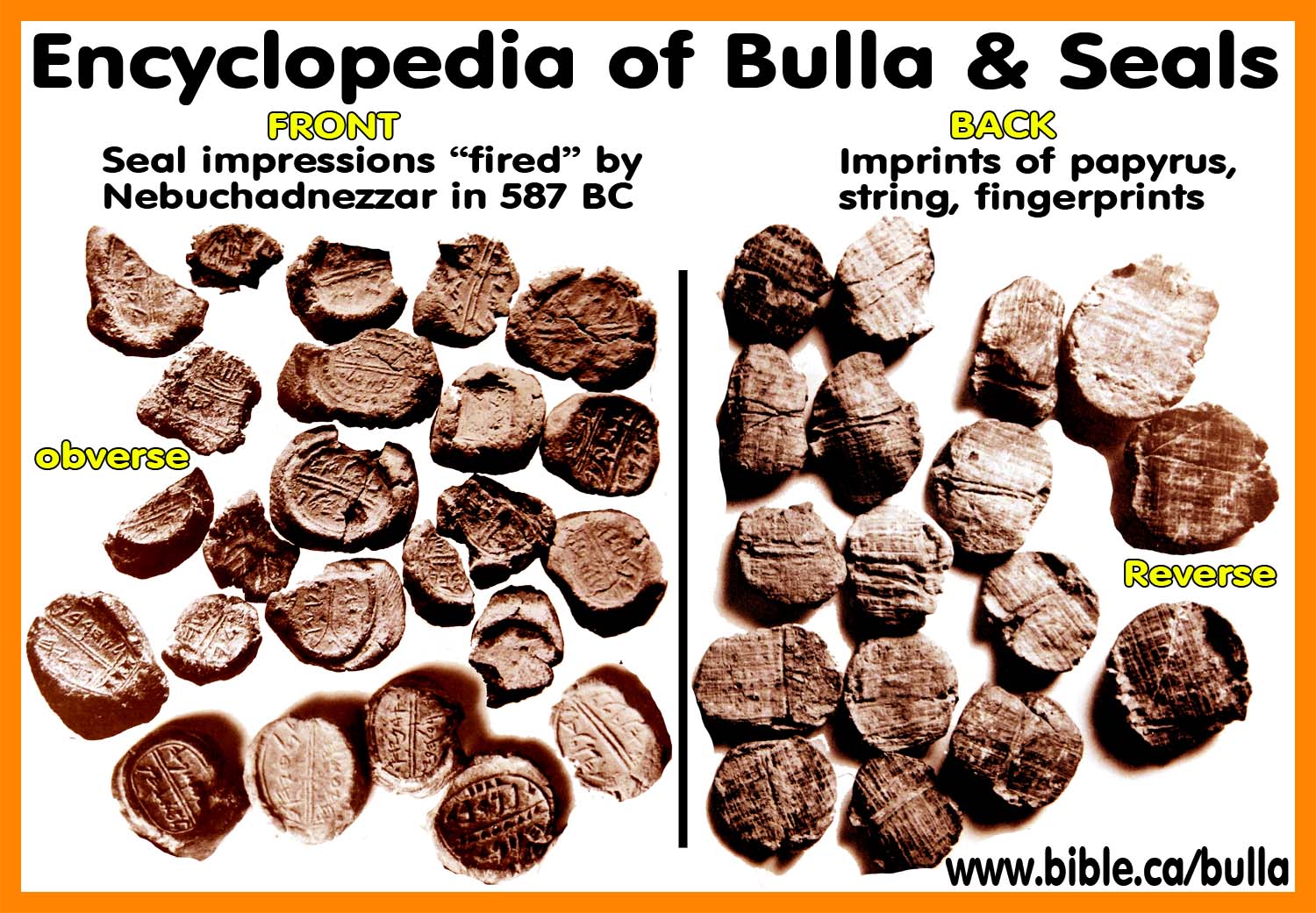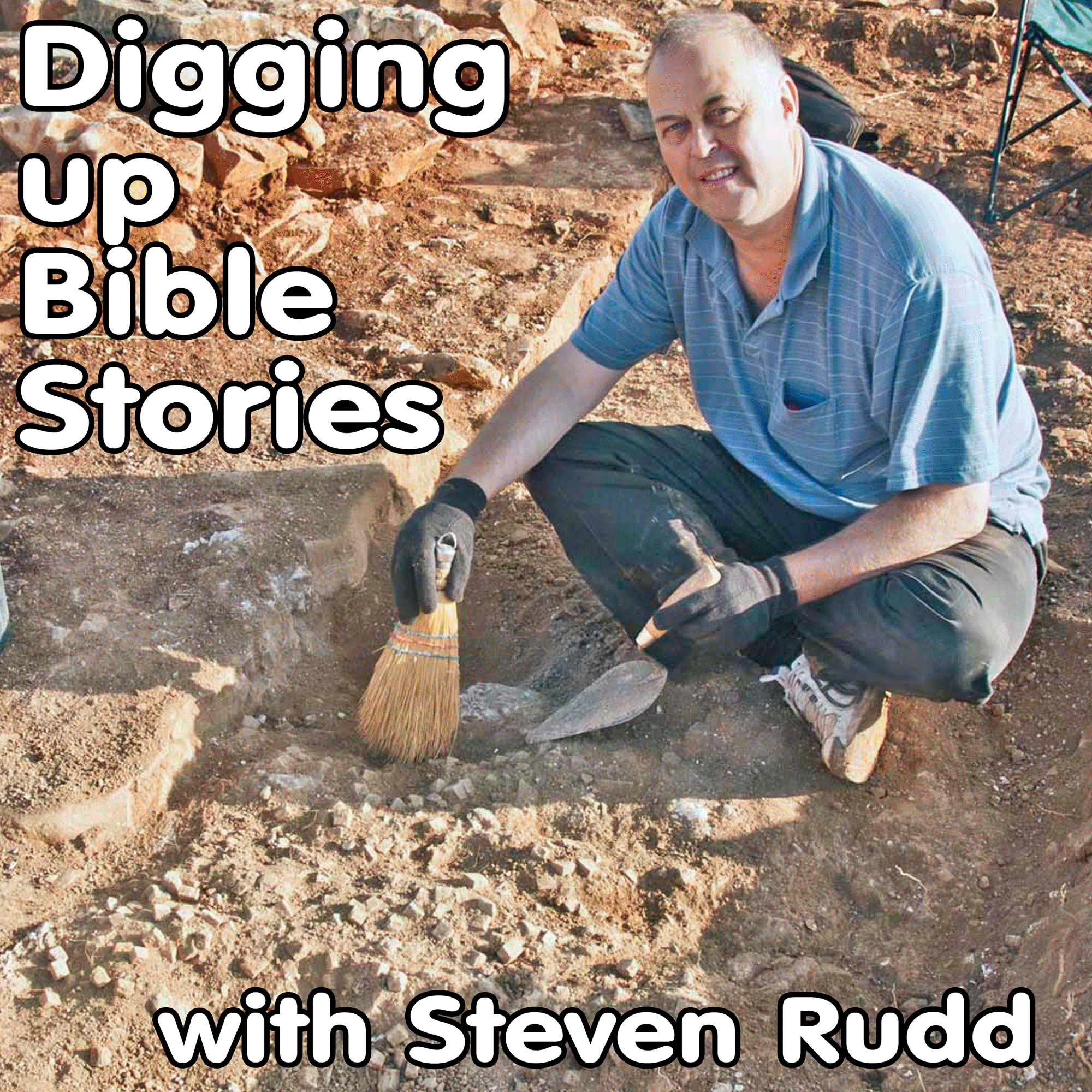Seal of Baalis King of Bnei-Ammon and the assassination of Gedaliah
Bible Seals and Bullae from Israel and Judah
|
Bulla of Baalis King of Bnei-Ammon "Archaeologists are digging up bible stories!!!" 1. Glyptic artifact: Brown agate seal 2. Inscription: "Belonging to Baalis King of Bnei-Ammon" 3. Provenance: None. Private antiquities market in 1999 AD. 4. Current location: Hecht Museum, Haifa Israel 5. Date: 587 BC 6. Bible verses: Jer 40:14 7. Events: Hired Ishmael to assassinate Gedaliah, 1st Judean governor appointed by Nebuchadnezzar in 587 BC |
|
|
||||||
|
Encyclopedia of Bullae and Seals: The Exhibit: On-line Museum of Bulla and seals Security: How bullae are made to seal papyrus Forgeries: Known fake bullae and seals |
||||||
|
|
||||||
|
Archaeologists are digging up bible stories!!! |
||||||
|
Archaeology is an important science that confirms the historical accuracy of the Bible. Since the Bible refers to hundreds of cities, kings, and places, we would expect to find evidence from on-site excavations. And this is exactly what we have found. The Bible is the most historically accurate book of history on earth. Read the Bible daily! |
|
|||||
|
|
||||||
Encyclopedia of Bullae and Seals of Judea and Israel
|
Seal "belonging to Baalis King of Bnei-Ammon" 1. Glyptic artifact: Brown agate seal 2. Inscription: "Belonging to Baalis King of Bnei-Ammon" 3. Provenance: None. Private antiquities market in 1999 AD. 4. Current location: Hecht Museum, Haifa Israel 5. Date: 587 BC 6. Bible verses: Jer 40:14 7. Events: Hired Ishmael to assassinate Gedaliah, 1st Judean governor appointed by Nebuchadnezzar in 587 BC |
Baalis, King of Ammon: 587 BC: Jeremiah 40:14
The assassination of Gedaliah
Introduction: The assassination of Gedaliah
- Archeology has uncovered six different bulla and seals of men involved in the assassination of Gedaliah! This is an excellent example of how archeology verifies in the ground what we read in the book.
- Baalas is a king of Ammon that succeeded in assassinating Gedaliah, the first governor of Judea by Nebuchadnezzar after deportation of Zedekiah and the destruction of the temple of Solomon.
- Baalas is unknown from outside written sources but is mentioned by name in one Bible verse:
- "Now Johanan the son of Kareah and all the commanders of the forces that were in the field came to Gedaliah at Mizpah and said to him, “Are you well aware that Baalis the king of the sons of Ammon has sent Ishmael the son of Nethaniah to take your life?” But Gedaliah the son of Ahikam did not believe them." (Jeremiah 40:13-14)
- Gedaliah the 1st governor of Judah:
- When Nebuchadnezzar deported Zedekiah in 587 BC he appointed this Gedaliah to be governor of Judah:
- Gedaliah was the son of Ahikam, (who was an important advisor to King Josiah: 2 Kgs 22:12, 14; 2 Chr 34:20) and the grandson of Shaphan.
- Gedaliah's father (Ahikam) and grandfather (Shaphan) where directly involved in the story of the lost book of the Law found under Josiah. It was Shaphan (a scribe) who first read the law and reported its contents.
- Gedaliah assassinated by Ishmael, whose bulla we have. His death was commemorated as the “fast of Gedaliah,” on the seventh month (Zech 7:5; 8:19) but today the third day of Tishri.
- Archeology has filled in the gaps so that what we read in the book we have found in the ground.
- We have the seal of Baalis from Jer
40:14
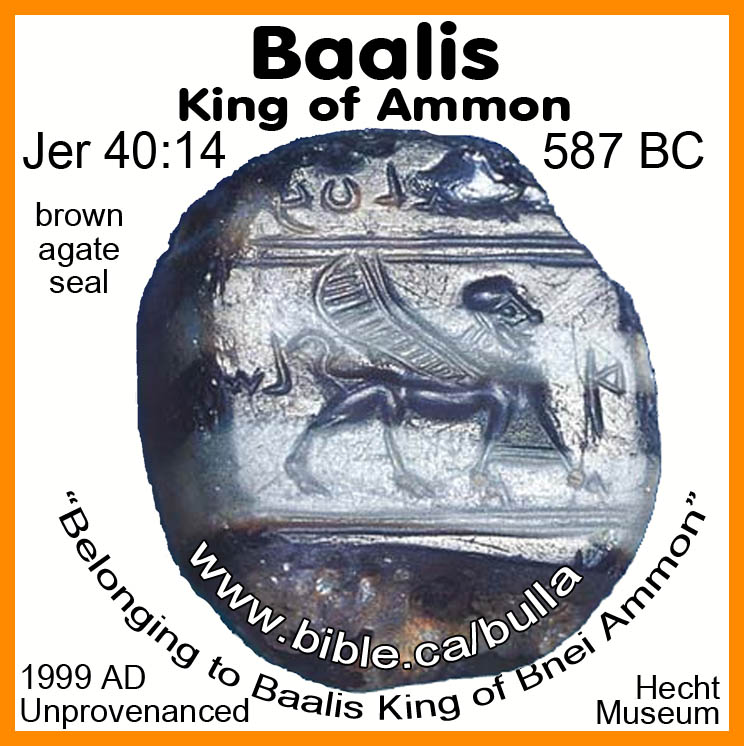
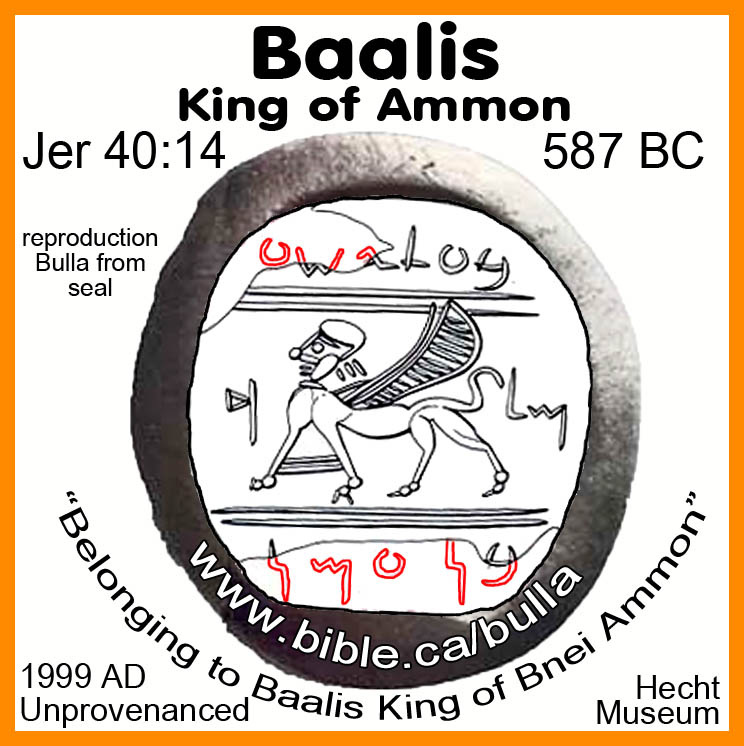

- We have the Bulla of Milkom servant of
Baalis who is not mentioned in the Bible.
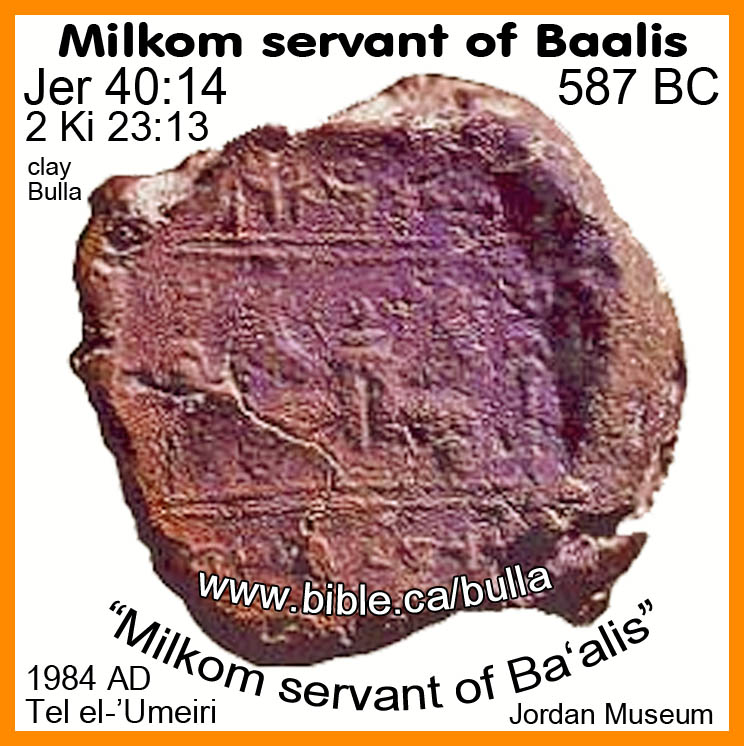

- We have the bulla of Gedaliah, the
governor whom Baalis assassinated through Ishmael.
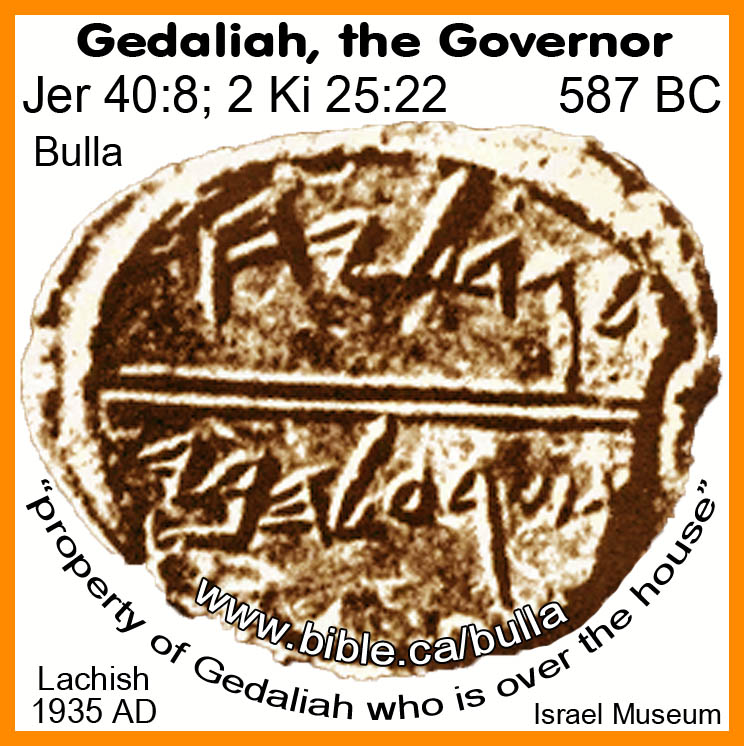
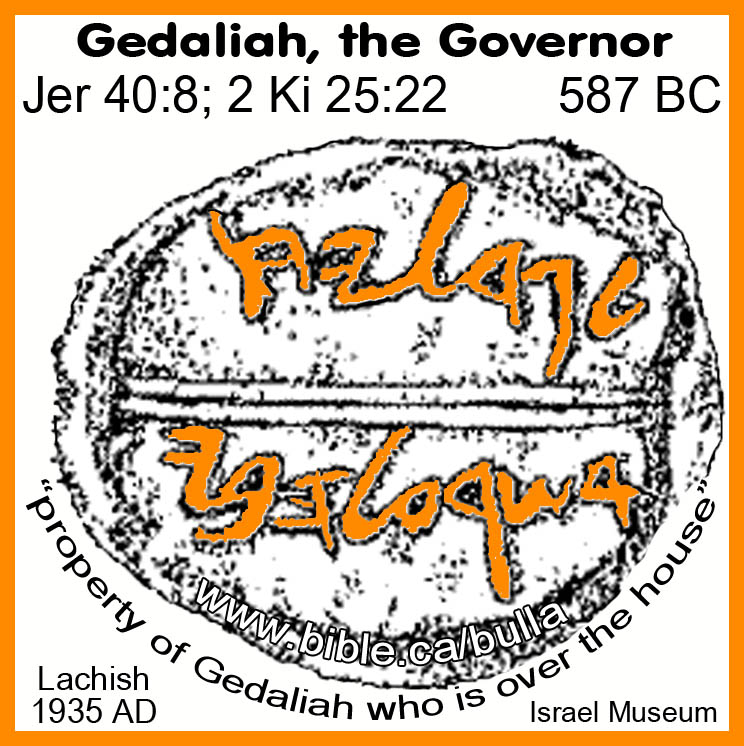
- We have the bulla of Ishmael the son of
Zedekiah, who was hired by Baalis to kill Gedaliah in Jer 40:14 and Zeph
1:8. Ishmael, the king's son. Zeph 1:8 shows a precedence that although
Ishmael was not directly the son of a king, he was of the royal family
and called a son.
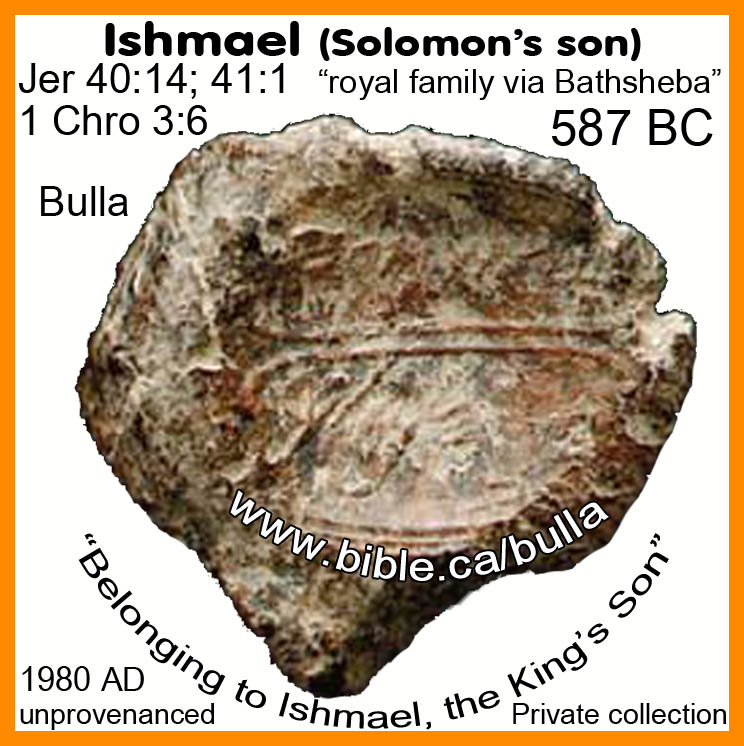

- We have the seal
of Jaazaniah servant of the king, son of a Maachathite
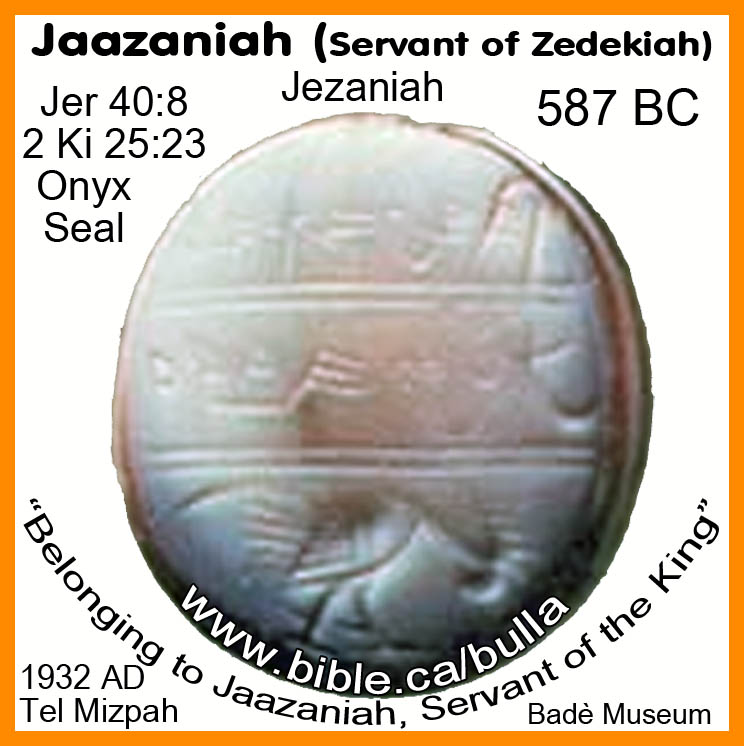
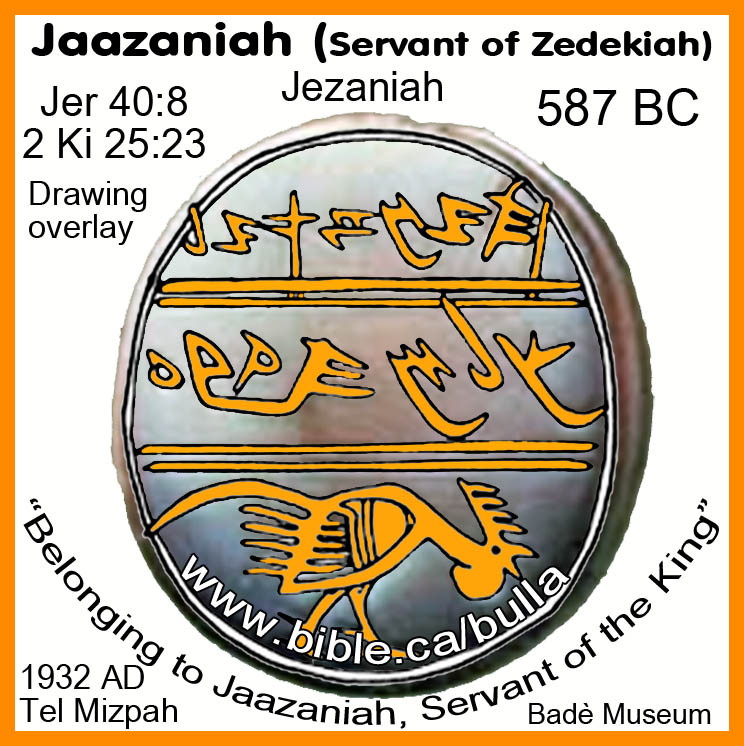
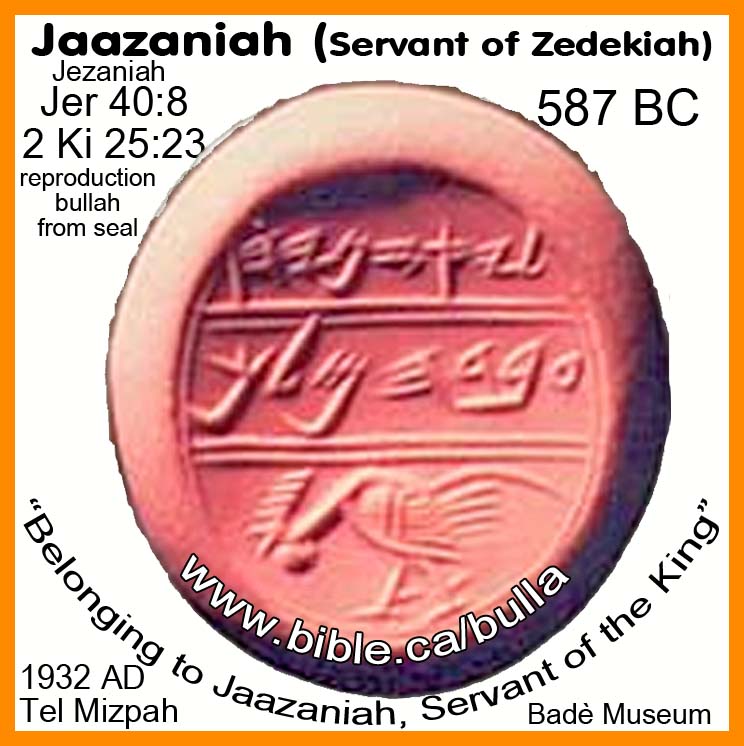
- Miamen Son of Ephai:


Archeological information about the seal of Baalis king of Bnei-Ammon:
- "What makes this seal especially exciting is that the king who owned the seal, a certain Ba‘alis, is also referred to in the Bible. When the Babylonians conquered Judah in the early sixth century B.C.E. and destroyed Jerusalem, they made Gedaliah, who was from a prominent Jerusalem family, governor of Judah. Gedaliah, however, was soon murdered, an event still commemorated in Jewish tradition by a yearly fast. The assassin was sent by none other than Ba‘alis, king of the Ammonites (Jeremiah 40:13–41:2). Ba‘alis’s seal (shown on the cover of this issue; the seal impression appears below) is made of brown agate with white bands and is in fact quite tiny (.5 inches in diameter and .2 inches thick). A small hole was drilled through the center of the scarab-shaped seal for the setting. On the seal are three lines of script, each separated by double rules:" (Seal of Ba‘alis Surfaces, Ammonite king plotted murder of Judahite governor, Robert Deutsch, BAR 25:02, 1999 AD)
- "This king has been identified with the Baʿal-yishʿa mentioned on a seal impression found in 1984 at Tell el-ʿUmeiri, just S of Amman in Jordan (Geraty 1984; 1985). It was found in the sift from topsoil excavated near the W rim of the mound about 50 cm above the remains of a major public structure termed the Ammonite Citadel by the excavators. The seal impression itself (19 mm in diameter) was on the flat end of a fired ceramic cone (21 mm in length) which may have served as a stopper with identification for a juglet of unknown contents. The finely conceived and executed seal impression is divided into 3 panels. The top and bottom panels contain the Ammonite inscription, dated paleographically to ca. 600 b.c. (Herr 1985b and fc.). The middle panel depicts typically Ammonite iconography (Younker 1985): a 4-winged scarab beetle pushing a solar ball flanked by standards, solar discs, and crescent moons in an assemblage reminiscent of Zeph 1:4–6. The inscription reads lmlkm-ʾwr ʿbd bʿl-yšʿ, “belonging to Milkom-ʾur, servant of Baʿal-yishʿa (or Baʿal-yashaʿ).” Both of the personal names, that of the owner of the seal and that of the king he served, constitute “firsts.” Milkom-ʾor (“Milkom is light”) or Milkom-ʾur (“Milkom’s flame”), represents the first-known occurrence in which Milkom, the well-known Ammonite divine name, appears as one of the elements in an Ammonite proper name. According to his title, “servant,” this individual would have been a prominent government official in the service of the Ammonite king, Baʿal-yishʿa (“Baal is salvation”) or Baʿal-yashaʿ (“Baal saves”). The latter is identified with the Baalis of Jer 40:14, and this reference to him is his first extrabiblical confirmation—despite Wright’s (1974:3) claim about “Baʿlay” being on the Tell Siran bottle (a misunderstanding of Cross 1973), misinformation perpetuated by Feinberg (1982:272). (ABD, Baalis)
- Line 1: [ע]בעלישׁ[לְ] ([l]b‘lyš[‘]) “[Belonging to] Ba‘ališ[‘]”
- Line 2: מלך (ml/k) “King of”
- Line 3: ן[נעם]ב (b[n’m]n) “B[nei Ammo]n.”
- "When Jephthah subdued the Ammonites, “he smote them … as far as Abel-keramim” (Judges 11:33), whose ruins today constitute Tell el ‘Umeiri, a Jordanian site about 37 miles east of Jerusalem. Occupied from about 3000 B.C. to nearly 500 B.C., the site has been linked with the Ammonite king Baalis (Jeremiah 40:14) and with Pharaoh Thutmose III (1479–1425 B.C.). In past seasons, excavators have found an early sixth-century B.C. bulla with the inscription, “Belonging to Milkom-or, the servant of Baalyasha” (the Baalis of Jeremiah 40:14), and a jar handle stamped with the cartouche of Thutmose III." (Tell el ‘Umeiri-Madaba Plains Project, BAR 14:06, 1988 AD)
- "The nearby city fortress of Lachish provides clear proof that it had been twice burned over a short period of time, coinciding with the two captures of Jerusalem. In Lachish the imprint of a clay seal was found, its back still shows the fibers of the papyrus to which it had been attached. It reads: “The property of Gedaliah who is over the house.” We meet this distinguished individual in 2 Kings 25:22, where we are told: “And as for the people that remained in the land of Judah, whom Nebuchadnezzar king of Babylon had left, even over them he made Gedaliah…ruler.” (Elder, John. Prophets, Idols, and Diggers. New York: Bobbs-Merrill, 1960 108, 109), (Evidence for Christianity, Josh McDowell, p164, 2006 AD)
- "Another important seal impression was found at Lachish in 1935 by the Welcome Archaeological Expedition of England. The inscription on it reads, “Belonging to Gedaliah, the one who is over the house,” and the reverse side shows the marks of a papyrus roll to which it had been stuck. In other words it was Gedaliah’s personal seal to a letter or official document which he had just written. Since the impression is dated by its archaeological context to the very end of the Divided monarchy, we are safe in assuming that Gedaliah is the same person who was the friend of Jeremiah (Jer. 39:14 and 40:1ff.) and whom Nebuchadnezzar made governor of Judah after the destruction of Jerusalem in 586 B.C. (II Kings 25:22). The title which he bore, “the one who is over the house,” was always used to designate one of the highest royal officials (cf. Gen. 43:16 where in the Hebrew the office of Joseph’s “steward” is described in the same way, and Isaiah 22:15 where the phrase is applied to an official of Hezekiah). Perhaps “Governor of the Palace” would be a fairly accurate translation of the title. Gedaliah himself must have been well trained for his position, for his grandfather, Shaphan, was also a royal official—the scribe or secretary of King Josiah." (Biblical Archeologist, Some Personal Seals of Judean Royal Officials, G. Ernest Wright, Vol 1)
- "In the ruins of Tell en-Naṣbeh (Mizpah?) a seal was found bearing the identifying inscription “To Jaazaniah, servant of the king.” Jaazaniah was one of the officials associated with Gedaliah (2 K. 25:23; Jer. 40:8). A seal impression found among the ruins of Lachish (thus antedating its destruction) bears the inscription, “Gedaliah who is over the house.” Thus G. Ernest Wright (WBA, p. 181) suggests that Gedaliah had served as one of the last prime ministers of Judah, because the words “who is over the house” refer to the office of prime minister. Not only was Gedaliah’s father a high official in his own right (Jer. 26:24), but his grandfather Shaphan had served Josiah as scribe, or secretary of state (2 K. 22:3, 8–12)." (ISBE, Rule of Gedaliah, Volume 2, Page 919, 1979 AD)
- Since this seal was found at tel Mizpah, it seems obvious to associate this Jaazaniah with the Gedaliah the first governor of Judah who used Mizpah as his home city. (2 Ki 25:23; Jer 40:8)
- Jaazaniah was in Mizpah at the same time as Gedaliah
- Jaazaniah was called the servant of the king and since Gedaliah was NEVER called a KING and since
- Jaananiah was hostile to Gedaliah and part of the assassination plot.
- Therefore it makes perfect sense that Jaazaniah served king Zedekiah.
Ishmael, the king's son. Zeph 1:8 shows a precedence that although Ishmael was not directly the son of a king, he was of the royal family and called a son.
By Steve Rudd: Contact the author for comments, input or corrections.
